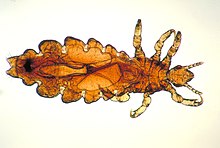Pediculosis
| Classification according to ICD-10 | |
|---|---|
| B85 | Pediculosis [lice infestation] and phthiriasis [pubic lice infestation] |
| B85.0 | Pediculosis due to Pediculus humanus capitis Head lice infestation |
| B85.1 | Pediculosis due to Pediculus humanus corporis clothing lice infestation |
| B85.2 | Pediculosis, unspecified |
| B85.3 | Phthiriasis ( pubic lice infestation ) |
| B85.4 | Mixed forms of pediculosis and phthiriasis |
| ICD-10 online (WHO version 2019) | |

The pediculosis ( Pediculosis ) outdated, even lice addiction called, is a parasitic disease , which is an infestation of the skin by head , felt or body lice comes. It can be transmitted and is unpleasant because of the itching caused by the bites and / or excretions of the lice , but otherwise harmless. However, lice can transmit pathogens.
illness
Pediculosis is classified as a common and epidemic disease, especially in children's communities. It occurs worldwide, regardless of the climatic zone.
therapy
The medicinal substances hexachlorocyclohexane , malathion , permethrin , pyrethrins and crotamiton are used in the form of shampoos , gels, lotions, ointments and sprays to treat pediculosis . After treatment with the medication, further treatment with a water-vinegar mixture is advantageous. This mixture, which consists of 1/2 cup of water and. 1/2 cup of vinegar is best to spread on the head every day, as the young cannot survive long because of the acid. In addition, however, the nits (lice eggs) must be removed from the hair with your fingers or a special lice comb.
swell
- ↑ A. Müller, RW Schlecht, Alexander Früh, H. Still The way to health: A faithful and indispensable guide for the healthy and the sick. 2 volumes, (1901; 3rd edition 1906, 9th edition 1921) 31st to 44th edition. CA Weller, Berlin 1929 to 1931, Volume 2 (1929), pp. 233-235 ( lice and lice addiction ).
- ↑ Christine J. Ko, Dirk M. Elston: Pediculosis. In: Journal of the American Academy of Dermatology , Volume 50, No. 1, 2004, pp. 1-12. doi : 10.1016 / S0190-9622 (03) 02729-4 .
- ↑ Conseil Supérieur d'Hygiène Publique de France: Conduite à tenir devant un sujet atteint de pédiculose du cuir chevelu (French)
- ↑ Guggisberg et al .: Scabies and Pediculosis Epidemiology, Management and Prevention in Swiss NOSO Bulletin, Volume 5 No. 4, Dec 1998
